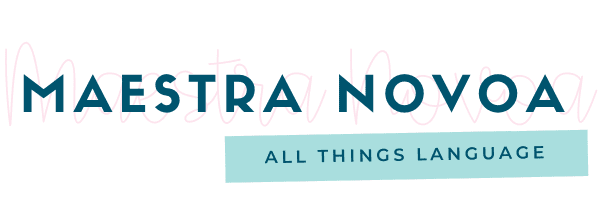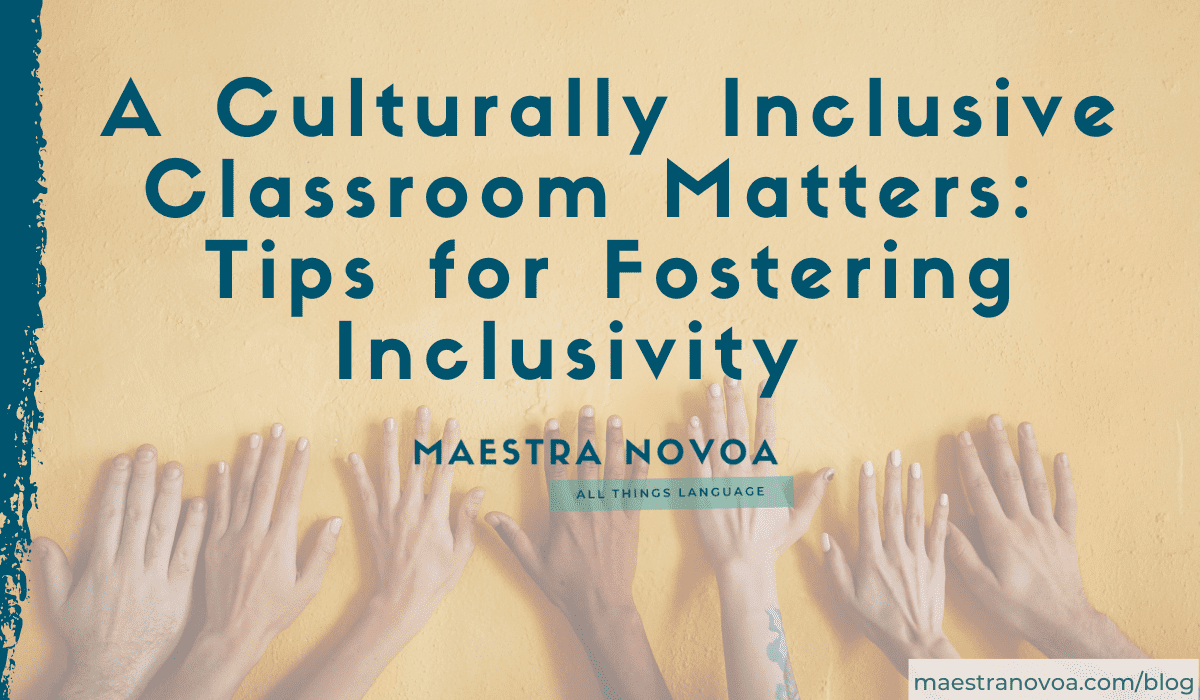Creating a culturally inclusive classroom may seem like a big challenge at first, but these simple tips for fostering inclusivity will get you on the right path. Let’s start with why we need to do this as educators.
The United States is a very diverse country in terms of race, ethnicity, religion, language, and culture. According to the United States Census Bureau, the racial and ethnic composition of the country as of 2020 is 60.1% white which leaves 39.9% of other! Included in the other are Hispanic/Latinx 18.5%, Black or African American 13.4%, Asian 5.9%, two or more 2.9%, and other at 6.2%. This set of data helps proves that we need culturally inclusive classrooms. It’s our duty to be connecting and teaching all of our students. Keep on reading for tips on making your classroom foster equity and inclusivity.
Flashback in (Culturally Inclusive?) Classroom
“I only remember one story from my elementary school. It was a book about a man using a new spoon for every bite of food he would take. That spoon was a tortilla!” These are my husband’s words as he reflects back on his education in a rural town in Idaho. Why is it that he could only remember ONE story? And why was it a story about a tortilla?
Unfortunately, a lot of his school experiences weren’t positive, but this one story resonated with him because it related directly to his family and cultural background. In this one instance, he could see himself represented in the story.
According to Reyes and Klyen (2010), “we can enable children and youth to develop the strong self-concept and cross-cultural understandings that are required to thrive in our multicultural world” when we represent their cultural backgrounds in curriculum and instruction. So how can we as educators do this to ensure that have culturally inclusive classrooms? Keep scrolling for tips on inclusivity!
PS- Here is a link to the book, A Spoon for Every Bite if you’re interested in using it in your classroom!
Tips for Creating a Culturally Inclusive Classroom
Are you thinking right now “how am I going to represent all students all the time to foster equity and inclusivity?” I know I have thought that plenty of times, but good news! We don’t have to do it to ALL the time. What we do need to do is make sure we are aware of the need and “sprinkle” as much representation as we can. Here is a great post from Read to Lead that goes into depth on Why It’s Critical for Students to “See Themselves” in Classroom Materials.
The tips I am sharing with you are easy to implement, take little time, and meet the goal of providing equity and inclusivity. Let’s get started with making your classroom culturally inclusive!
Tip 1: Use multicultural names in scenarios
To start fostering inclusivity, simply start using names from around the world in your word problems, questions, and classroom scenario examples. I personally like using students’ names that I’ve had in the past. Other ways to come up with names are to Google them, find them in books, or ask students.
Here is a task card for a Pythagorean theorem unit:
Click here if you’re interested in having a closer look at this set of task cards in my TPT store.
Here is another example of a bellringer. Have students explain who is correct and why, but make sure to plop in names that aren’t common.

Tip 2: Include foods and places that relate to your students
As students read about two different food stands for their math problem, one American student was confused about what dolma and fufu were. It was a great opportunity for his classmates to step in and share about their favorite foods and share a piece of their culture. In this particular case, they felt like the experts in the room.
Not only was it a good opportunity to share their background with their classmate, but it was a great opportunity to understand the context of the math problem better. One of the students from Iraq mentioned the unit price for the dolma should have been higher.
Here is a non-math example. It is a comparison of cultural aspects for a social studies class. The topic of the unit was Ancient greek, but I found a way to incorporate Peru and a Native American tribe.
For some content areas and topics, you will have to be creative on how to sprinkle in students’ backgrounds, but it can be done. I’d be happy to brainstorm with you too! Leave a comment below or shoot me an email.
Tip 3: Use students’ L1s in class
Students LOVE when they can use their native language in the classroom. We should really encourage students to use all their language repertoires, especially since using languages other than English used to be banned in classrooms. This is for real! Check this out:
“In 1918, Texas, along with many other states, enacted statutes that made the speaking of any language other than English on public school grounds illegal. These laws remained active until the U.S. Congress passed the Bilingual Education Act in 1968.” -Brian Birdwell
There is a super neat documentary called When I Dream Dreams. Here if you’d like to learn more.
How are some ideas on how to sprinkle in native language:
-Brain breaks! Have a student count in their native language while the class stretches
-Ask “How do we say _____ in your native language?” or “What does ______ mean in English?”
-Put the L1 word next to the L2 word in labeling, vocab wall, etc.
Here is an example from my class where students had to guess what word was being defined in a circle map. The world was “sphere”. When kids saw Swahili and Arabic on the morning bellwork, their faces lit up!
Not only was this simple activity successful in creating a culturally inclusive classroom, but it created a meaningful relation to the content providing the students with a more equitable education.
Tip 4: Books and stories from students’ backgrounds
When students see themselves reflected in the books they read, it helps them feel valued and included. It can also help them develop a sense of pride and connection to their culture and identity. When students feel seen and heard, they are more likely to feel motivated and engaged in learning.
This tip is a direct way of providing equity in the classroom. When students read books that are culturally relevant and engaging, they are more likely to become enthusiastic and motivated readers. This can help them develop stronger literacy skills, including vocabulary, comprehension, and critical thinking.
Speaking of inclusivity, I wrote a blog post about how to Strengthen School-Home Communication: Three Helpful and Practical Ways. The suggestions in this post are very practical and won’t add too much more to your load.
Here is a family homework letter freebie that can help you start connecting with home! It will save you time because all you have to do is update the date and your name. Easy peasy. It’s a great way to start off that communication with families. It’s even in English and Spanish for ya!
For two other ways to start communicating with families, check out my blog post here. The focus is EL students, but all students would benefit.
Recap on How to Create a Culturally Inclusive Classroom as You Foster Equity and Inclusivity
Overall, using these four tips for fostering equity and inclusivity by relating to students’ cultural backgrounds is an important way to promote academic success in any classroom. It’s clear that the diversity we see in classrooms in the United States is growing. As educators, we must be working towards fostering equity and inclusivity in our classrooms. I hope these tips make it easier for you to do so. One last thing…blunt truth comin’ at ya: it shouldn’t always be a student like Mapenzi struggling to read the names Jacob or Bobby. Students all over the world deserve to have culturally inclusive classrooms.




2 Responses